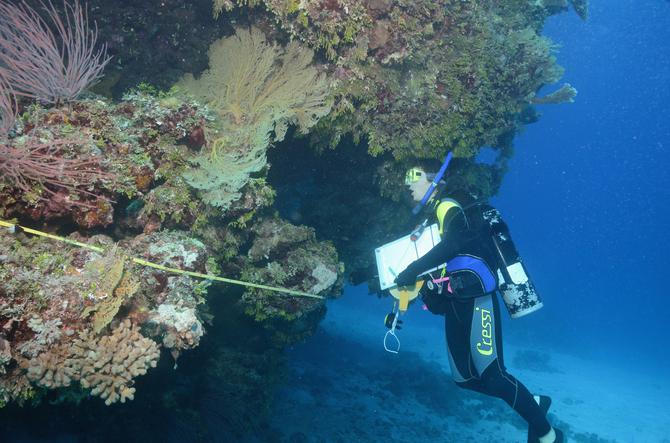Two hundred years after Matthew Flinders circumnavigated Australia and mapped much of the coastline for the first time, community citizen scientists and Institute for Marine and Antarctic Studies (IMAS) researchers are now following in his wake to record marine and shore life along the coast.
More than 100 volunteer divers from the global citizen science program Reef Life Survey have so far conducted more than 6,500 dives at 1,800 sites around the coastline, collecting unique first-time records in the shallow coastal regions to allow future changes in fish and shellfish populations to be accurately measured Australia-wide.
Professor Graham Edgar, who established Reef Life Survey and leads IMAS research into its findings with colleague Dr Rick Stuart-Smith, said the data collected were a unique resource used by researchers, government and the community.
He highlighted the dedication and enthusiasm of volunteer divers in expanding the reach of data collection across spatial scales impossible for dedicated teams of scientists to cover.
6,500
The amount of dives the RLS has conducted so far around the coastline.
Professor Graham Edgar, who established Reef Life Survey and leads IMAS research into its findings with colleague Dr Rick Stuart-Smith, said the data collected were a unique resource used by researchers, government and the community.
He highlighted the dedication and enthusiasm of volunteer divers in expanding the reach of data collection across spatial scales impossible for dedicated teams of scientists to cover.

Volunteer Reef Life Survey diver at Holmes Reef Coral Sea. Imae by Professor Graham Edgar.
You could say we saw Matthew Flinders as our inspiration, Professor Edgar said.
“Flinders circumnavigated Australia, mapping out the physical features, the headlands, the bays and the depths.
“Two hundred years later we’re following in his footsteps, only this time we’re mapping the biological features.
We’re counting the number of fishes, mammals, sharks, reptiles, sea urchins, crustaceans and molluscs, as well as coral and seaweed cover.
3000
The number of species recorded so far around the coast.
“So far we’ve recorded numbers of more than 3,000 species around the coast.
“These data will be used as reference for the next 200 years as a record of the biological environment at this time, providing an irreplaceable reference point to assess future change in the marine environment,” Professor Edgar said.
What was until now invisible under the sea is becoming visible through the efforts of our Reef Life Survey diving community.
“We’re creating a comprehensive record so people can be aware of exactly what changes are happening, how threats to our living heritage are distributed, and how managers might best deploy their resources to remedy those threats.”
“Reef Life Survey divers have recently repeated five months of surveys at more than 250 sites across the span of the Great Barrier Reef and Coral Sea, providing detailed information on how fishes and other marine life were affected by coral bleaching last year.
“These surveys provide a unique record of marine life before and after the largest known bleaching event to date, complementing the work of other researchers monitoring impacts on coral.”
Professor Edgar said that in addition to its records of Australian marine life, Reef Life Survey also operates internationally, with surveys conducted at 3,000 sites globally by divers in 50 countries.
About the Reef Life Survey:
Reef Life Survey data has formed the basis of four articles in the prestigious international science publication Nature by IMAS researchers, as well as many other articles in leading journals. In 2014 the research was also recognised with an Australian Museum Eureka Award.
Reef Life Survey also provides one of the world’s most comprehensive and useful field guides to global marine species using information and images collected by divers globally: http://reeflifesurvey.com/species-search
Interested in exploring the oceans? Find out about our Marine and Antarctic study options here.